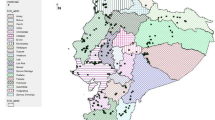Abstract
Isozyme polymorphism can assist in the identification of cherry cultivars. Ten isozymes, each showing variation at only one locus, provide 70 unique genotype profiles from leaf extracts of 78 different sweet cherry cultivars. Polymorphism in 6PGD, G6PD, GPI, IDH, PGM, FDP, SKDH and PER is demonstrated for the first time, while observations are extended for the previously described polymorphisms in MDH and GOT. Some cultivars with identical morphological characters and previously treated as one cultivar can be separated on the basis of isozyme genotype. Irradiated mutants and parent material could also be differentiated.
Similar content being viewed by others
References
Arulsekar S, Parfitt DE (1986) Isozyme analysis procedures for stone fruits, almond, grape, walnut, pistachio and fig. Hort Science 21:928–933
Ashari A, Aspinall D and Sedgley M (1989) Identification and investigation of relationships of mandarin types using isozyme analysis. Scientia Horticulturae 40, 305–315
Bargioni G (1979) La ciliegia “Vittoria” caratteristiche pomologiche e producttive informatore. Agrario 35:6289–6291
Bowman FT (1937) Cherry pollination and variety investigations in New South Wales 1930–34. Depth Agric NSW Sci Bull 55:5–49
Brown SK, Way RD, Terry DE (1989) Sweet and Tart cherry varieties: descriptions and cultural recommendations. New York Food Life Sci Bull no 127
Boucher WD (1991) Sweet cherry trial results — 1990/91 growing season. Stone and Berryfruits Newslett, DPI Tasmania no 2:10–12
Brooks RM, Olmo HP (1971) Register of new fruit and nut varieties. List 26. Hort Science 5:441
Button T (1982) Sweet cherries bred for self-fertility. Can Fruit Grower Sept 1982:9–10
Crane MB, Brown AG (1937) Incompatibility and sterility in the sweet sherry,Prunus avium L. J Pomol Hort Sci 15:86–116
Grubb NH (1949) Cherries. Crosby Lockwood and Son Ltd, London
Hancock AM, Iezzoni AZ (1988) Malate dehydrogenase isozyme patterns in sevenPrunus species. Hort Science 23:381–383
Hedrick UP (1915) The cherries of New York. Rep NY St Exp Stn 1914, pt 2
Jackson JF, (1992) Genotype determination in almond nuts for paternity analysis Mod Methods Plant Anal 14:1–16 Springer, Berlin Heidelberg New York Tokyo
Jackson JF, Clarke GR (1991) Gene flow in an almond orchard. Theor. Appl Genet 82:169–173
Kephart SR (1990) Starch-gel electrophoresis of plant isozymes: a comparative analysis of techniques. Am J Bot 77:693–712
Knight RL (1969) Abstract bibliography of fruit breeding and genetics to 1965.Prunus Tech Commun no 31. Commonwealth Agricultural Bureau, Bucks, England
Krapf B, Theiler R (1973) Basler Langstieler and excellent pollinator cultivar in sweet cherry orchards. Schweiz Z Obst Weinbau 109:608–611
Lane WD, Schmid H (1984) Lapins and Sunburst sweet cherry. Can J Plant Sci 64:211–214
Lapins KO (1971) Stella, a self-fruitful sweet cherry. Can J Plant Sci 51:252–253
Lapins KO (1974a) Compact Stella sweet cherry. Can J Plant Sci 54:849–850
Lapins KO (1974b) Summit Sweet Cherry. Can J Plant Sci 54: 851
Lapins KO, Schmid H (1972) New fruits from Summerland, British Columbia 1956–1960. Publ Can Dept Agric no 1471
Matthews P, Dow KP (1970) Breeding for resistance to bacterial canker in cherries. John Innes Inst 61st Annu Rep. F. Crowe and Sons. Norwich, UK, pp 21–23
Matthews P, Dow KP (1971) Breeding for resistance to bacterial canker in cherries. John Innes Inst 62nd Annu Rep. F. Crower and Sons Norwich, UK, pp 24–25
Matthews P, Dow KP (1973) Breeding for resistance to bacterial canker in cherries. John Innes Inst 64th Annu Rep. F. Crower and Sons Norwich, UK, pp 18–21
Matthews P, Dow KP (1974) Breeding for resistance to bacterial canker in cherries. John Innes Inst 65th Annu Rep. F. Crower and Sons Norwich, UK, p 18
Matthews P, Dow KP (1975) Breeding for resistance to bacterial canker in cherries. John Innes Inst 66th Annu Rep. F. Crower and Sons Norwich, UK, p 17
McVittie AC (1984) Cherry rootstocks Cob and Colt. Rep E. Mailing Stn 1983 Maidstone, Kent. Headly Bros, Invicta Press, London
Northcote KM (1979) A factual key for the recognition of Australian soils, 4th edn. Rellim Techn Pub, Glenside, S. Australia
Pierce LC, Brewbaker JL (1973) Applications of isozyme analysis in horticultural science. Hort Science 8:17–22
Richardson BJ, Baverstock PR, Adams M (1986) Allozyme electrophoresis. A handbook for animal systematics and population studies. Academic Press, Sydney, pp 99–144
Santi F, Lemoine M (1990) Genetic markers forPrunus avium L: inheritance and linkage of isozyme loci. Ann Sci For 47:131–139
Schaer E (1973) The cherry variety Magda. Schweiz Z Obst-Weinbau 109:90–92
Schaer E, Krapf B, Theiler R (1975) The new processing cherry cultivars Gamma and Delta raised at the federal research station, Wädenswil. Schweiz Z Obst Weinbau 111:83–87
Soltis DE, Haufler CH, Darrow DC, Gastony GJ (1983) Starchgel electrophoresis of ferns: a compilation of grinding buffers, gel and electrode buffers and staining schedules. Am Fern J 73:9–27
Tehrani G, Dickson GH (1967) Vega and Valera sweet and cherries. Hort Res Inst Ontario Rep 1967, p 58
Thieler-Hedtrich R (1985) Sweet cherry breeding programme at the swiss federal research station. I. Results of fruit characters and flowering period inheritance. Acta Hort 169:51–62
Weeden NF, Lamb RC (1985) Identification of apple cultivars by isozyme phenotypes. J Am Soc Hort Sci 110:509–515
Author information
Authors and Affiliations
Additional information
Communicated by H. F. Linskens
Rights and permissions
About this article
Cite this article
Granger, A.R., Clarke, G.R. & Jackson, J.F. Sweet cherry cultivar identification by leaf isozyme polymorphism. Theoret. Appl. Genetics 86, 458–464 (1993). https://doi.org/10.1007/BF00838561
Received:
Accepted:
Issue Date:
DOI: https://doi.org/10.1007/BF00838561



